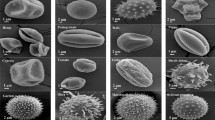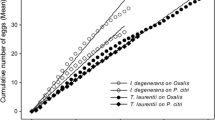Abstract
The influence of feeding and temperature on life table parameters ofEuseius stipulatus (Athias-Henriot) andTyphlodromus phialatus Athias-Henriot was determined in laboratory tests. Both phytoseiids developed and reproduced readily when fed onCarpobrotus edulis (L.) pollen andPanonychus citri (McGregor) Intrinsic rates of increase (r m ) at 25°C forE. stipulatus andT. phialatus were 0.197 and 0.126, and, when fed onP. citri, 0.129 and 0.144, respectively.Tetranychus urticae Koch offered as prey allowed normal development and oviposition ofT. phialatus, but no eggs were laid byE. stipulatus when fed on this spider mite. Eggs and honeydew ofAleurothrixus floccosus Mask. furnished sufficient nutrition for development of immatures ofE. stipulatus. Larvae ofPlanoccocus citri Risso, and honeydew and eggs ofA. floccosus, allowed adult survival but no egg-laying of the predaceous mites.Lorryia formosa Cooreman was not a favoured prey species.
Life tables were calculated forE. stipulatus fed on pollen andT. phialatus fed onP. citri at constant temperatures of 18, 25, and 32°C. Maximum development was reached at 32°C, withr m values of 0.225 forE. stipulatus and 0.179 forT. phialatus. In general, both phytoseiids showed medium to high total number of eggs per female and long oviposition periods when compared with other phytoseiid species.
When mating took place at 32°C,E. stipulatus females were not able to lay eggs, thus suggesting an interference of high temperatures with fertilization in this species. No hatching was observed in eggs of either species when kept at relative humidities of 50% or lower. The possible significance of these responses is discussed in relation to population trends observed in the field.
Similar content being viewed by others
References
Amitai, S. and Swirski, E., 1978. A new genus and new records of phytoseiid mites (Mesostigmata: Phytoseiidae) from Israel, Israel J. Entomol., 12: 123–143.
Athias-Henriot, C., 1960. Phytoseiidae et Aceosejidae (Acarina: Gamasina) d'Algérie. IV. GenreTyphlodromus Scheuten, 1857. Bull. Soc. Hist. Nat. Afr. Nord, 51: 62–107.
Badii, M.H. and McMurtry, J.A., 1983. Effect of different foods on development reproduction and survival ofPhytoseiulus longipes (Acarina: Phytoseiidae). Entomophaga, 28(2): 161–166.
Birch, L.C., 1948. The intrinsic rate of natural increase of an insect population. J. Anim. Ecol., 17: 15–26.
Blommers, L., 1976. Capacities for increase and predation inAmblyseius bibens (Acarina: Phytoseiidae). Z. Angew. Entomol., 81: 225–244.
Chambers, D.L. and Moffitt, C., 1967. Improved laboratory methods for rearing the citrus red mite. J. Econ. Entomol., 60(6): 1748–1749.
Charlet, L.D. and McMurtry, J.A., 1977. Systematics and bionomics of predaceous and phytophagous mites associated with pine foliage in California. III. Laboratory studies on the biology of the phytoseiidsMetaseiulus validus Chant andTyphloseiopsis pini Chant. Hilgardia, 45(7): 223–236.
El Badry, E.A., Afifi, A.M., Issa, G.I. and El Benhawy, E.M., 1968. Effect of different prey species on the development and fecundity of the predaceous miteAmblyseius gossipi (Acarina: Phytoseiidae). Z. Angew. Entomol., 62: 247–251.
Ferragut, F., Costa-Comelles, J., Gomez-Bernardo, E. and Garcia-Marí, F., 1985. Contribución al conocimiento de los ácaros fitoseidos (Gamasida: Phytoseiidae) de los cultivos españoles. Actas do II Congr. Ibérico de Entomol. Lisboa, Junio 1985, 2: 223–231.
Ferro, D.N. and Southwick, E.E. 1984. Microclimates of small arthropods: Estimating humidity within the leaf boundary layer. Environ. Entomol., 13: 926–9.
Garcia-Marí, F. and Del Rivero, J.M., 1981. The red mitePanonychus citri (McGregor), a new pest of citrus in Spain. Bol. Ser. Def. Plagas, 7: 65–77 (in Spanish).
Garcia-Marí, F., Santaballa, E., Ferragut, F., Marzal, C., Colomer, P. and Costa-Comelles, J., 1983. The red mitePanonychus citri (McGr.), influence on the phytosanitary schedule of our orchards. Bol. Serv. Def. Plagas. 9: 191–218 (in Spanish).
Garcia-Marí, F., Ferragut, F., Costa-Comelles, J. and Marzal, C., in press. Population dynamics of the citrus red mitePanonychus citri (McGr.) and its predators in Spanish citrus orchards. Proc. Int. Soc. Citriculture, Brazil, 1984.
Henneberry, T.J., Flint, H.M. and Bariola, L.A., 1977. Temperature effects on mating, sperm transfer, oviposition and egg viability of pink bollworm. Environ. Entomol., 6(4): 513–517.
Kennett, C.E. and Hamai, J., 1980. Oviposition and development in predaceous mites fed with artificial and natural diets (Acari: Phytoseiidae). Entomol. Exp. Appl., 28: 116–122.
Ligouri, M., 1980. Contribution to the knowledge of vineyard mites Toscana. Redia, 63: 407–415.
Ma, M.L. and Laing, J.E., 1973. Biology, potential for increase and prey consumption ofAmblyseius chilenensis (Dosse) (Acarina: Phytoseiidae) Entomophaga, 18(1): 47–60.
McMurtry, J.A., 1977. Some predaceous mites (Phytoseiidae) on citrus in the Mediterranean region. Entomophaga, 22(1): 19–30.
McMurtry, J.A. and Scriven, G.T., 1965a. Insectary production of phytoseiid mites. J. Econ. Entomol., 58(2): 282–284.
McMurtry, J.A. and Scriven, G.T. 1965b. Life history studies ofAmblyseius limonicus, with comparative studies onAmblyseius hibisci (Acarina: Phytoseiidae). Ann. Entomol. Soc. Am., 58: 106–111.
McMurtry, J.A. and Scriven, G.T., 1966. The influence of pollen and prey density on the number of prey consumed byAmblyseius hibisci (Acarina: Phytoseiidae). Ann. Entomol. Soc. Am., 59: 147–149.
McMurtry, J.A. and Scriven, G.T., 1975. Population increase ofPhytoseiulus persimilis on different insectary feeding programs. J. Econ. Entomol., 68(3): 319–321.
McMurtry, J.A., Huffaker, C.B. and Van de Vrie, M., 1970. Ecology of tetranychid mites and their natural enemies: a review. I. Tetranychid enemies: their biological characters and the impact of sprays practices. Hilgardia, 40(11): 331–390.
McMurtry, J.A., Mahr, D.L., and Johnson, H.G., 1976. Geographic races in the predaceous miteAmblyseius potentillae (Acari: Phytoseiidae). Int. J. Acarol., 2(1): 23–28.
Moraes, G.J. de and McMurtry, J.A., 1981. Biology ofAmblyseius citrifolius (Denmark and Muma) (Acarina: Phytoseiidae). Hilgardia, 49(1): 1–29.
Munger, F. and Gilmore, J.E., 1960. Mass production of the citrus red mite. J. Econ. Entomol., 53(5): 964–6.
Rabbinge, R., 1976. Biological Control of the Fruit Tree Red Spider Mite. Simulation Monographs. Pudoc, Wageningen, 228 pp.
Ragusa, S., 1979. Laboratory studies on the food habits of the predaceous miteTyphlodromus exhilaratus. In: J.G. Rodriguez (Editor), Recent Advances in Acarology, Academic Press, New York, pp. 485–490.
Sabelis, M.W., 1981. Biological control of two-spotted spider mites using phytoseiid predators. Part I: Modelling the predator-prey interaction at the individual level. Agric. Res. Reprints 910, Pudoc, Wageningen, 242 pp.
Saitō, Y. and Mori, H., 1981. Parameters related to potential rate of population increase of three predacious mites in Japan (Acarina: Phytoseiidae). Appl. Entomol. Zool., 16(1): 45–47.
Sanderson, J.P. and McMurtry, J.A., 1984. Life history of the predaceous mitePhytoseius hawaiiensis. Entomol. Exp. Appl., 35: 227–234.
Schulten, G.G.M., 1985. Pseudo-arrhenotoky. In: W. Helle and M.W. Sabelis (Editors), Spider Mites, their Biology, Natural Enemies and Control. Elsevier, Amsterdam, Vol. 1B, pp. 67–71.
Sugai, E. and Ashous, T., 1968. Sterilizing effect on high temperature in the male silkwormBombyx mori L. (Lepidoptera: Bombycidae). Appl. Entomol. Zool., 3: 99–102.
Tanigoshi, L.K., 1981. Advances in the knowledge of the biology of the Phytoseiidae. In: M.A. Hoy (Editors), Recent Advances in Knowledge of the Phytoseiidae. Div. Agric. Sciences, Univ. of California, 99 pp.
Tanigoshi, L.K. and McMurtry, J.A., 1977. The dynamics of predation ofStethorus picipes (Coleoptera: Coccinellidae) andTyphlodromus floridanus on the preyOligonychus punicae (Acarina: Phytoseiidae, Tetranychidae). Part I. Comparative life history and life table studies. Hilgardia, 45(8): 237–261.
Tanigoshi, L.K., Hoyt, S.C., Browne, R.W. and Logan, J., 1975. Influence of temperature on population increase ofMetaseiulus occidentalis (Acarina: Phytoseiidae). Ann. Entomol. Soc. Am., 68(6): 979–986.
Tanigoshi, L.K., Fargerlund, J. and Nishio-Wong, J., 1981. Significance of temperature and food resources to the developmental biology ofAmblyseius hibisci Chant (Acarina: Phytoseiidae). Z. Angew. Entomol., 92: 409–419.
Author information
Authors and Affiliations
Rights and permissions
About this article
Cite this article
Ferragut, F., Garcia-Marí, F., Costa-Comelles, J. et al. Influence of food and temperature on development and oviposition ofEuseius stipulatus andTyphlodromus phialatus (Acari: Phytoseiidae). Exp Appl Acarol 3, 317–329 (1987). https://doi.org/10.1007/BF01193168
Received:
Issue Date:
DOI: https://doi.org/10.1007/BF01193168




